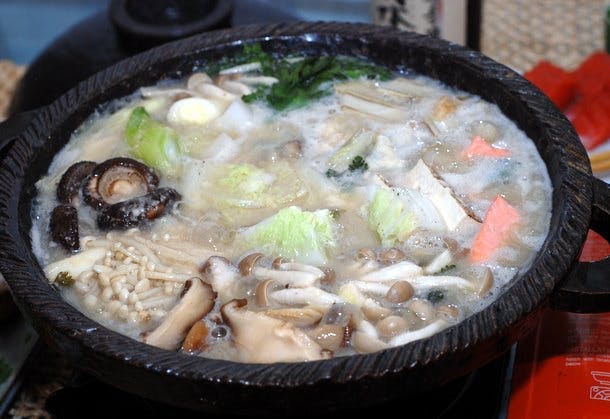
salmon hotpot
Discover the traditional Ishikari Nabe hotpot recipe from Hokkaido, Japan honoring the Ishikari River, along with a contemporary twist. This article shares the ingredients used, cooking process, and the cultural significance of this delicious and versatile Japanese hotpot.
This hotpot hails from the far northern island of Hokkaido, a snowy, remote region famous for its salmon, crab, cattle and potatoes (an influence of nearby Russia), among other ingredients. It's called ishikari nabe in Japanese, in honor of Hokkaido's Ishikari River.
I found two recipes for this dish, one from a contemporary cookbook, the other from a more traditional one. I combined ingredients from both recipes to assemble this hotpot.
According to the traditional cookbook, families in Hokkaido sometimes substitute local milk and butter for sakekasu, and often add local potatoes, too. This cookbook also recommends a dashi (stock) prepared by first soaking konbu (kelp) in water for an hour, then simmering salmon bones and head to make a stock (in the fine tradition of wasting nothing in Japanese cooking). Salmon parts are plentiful in Hokkaido (ingredients collectively known as ara), but I guess you'll have to know a fishmonger or buy a whole salmon to find them here.
I decided instead to follow the contemporary cookbook's approach, which structures the hotpot as a progression of flavors that build on each other: First shiitake mushroom broth and sakekasu with green onions, then tangy yuzu kosho, and finally, white miso. This layering of flavors sounded amazing.
Here are the ingredients we used (buy enough, of course, for the number of people you're feeding):
-- shiitake, shimeji and enoki mushrooms
-- hakusai (Napa cabbage)
-- shungiku (chrysanthemum leaves)
-- naga negi (Japanese leeks)
-- kuzukiri (arrowroot noodles)
-- yaki tofu ("broiled" tofu)
-- gobo (burdock root)
-- daikon
-- dried shiitake mushrooms
-- sakekasu (sake lees)
-- saikyo miso (a style of white miso)
-- wild Coho salmon
-- yuzu kosho (aromatic yuzu citrus rind combined with white pepper)
-- green onions
Here's how we did it:
Several hours before dinner I salted the salmon and put in the refrigerator to cure slightly (overnight would be good, too). An hour before dinner I soaked four dried shiitake mushrooms in a mixing bowl of water, and soaked the kuzikiri in another bowl of water. Then I prepared the ingredients: I portioned the mushrooms, hakusai, shungiku, negi (white part only), yaki tofu and salmon into bite-size pieces. For the gobo, I scraped the skin off with the back of a knife, cut into one-inch or so piece and sliced lengthwise, before placing the slices in a bowl of cold water so they wouldn't discolor. For the daikon, I peeled it, then cut into two-inch rectangles, a half an inch thick. For the green onion, I thinly sliced both the white and green parts. Once cut, I arranged all the ingredients on serving platters, save the gobo, which stayed in the water. I also put the saikyo miso and yuzu kosho into bowls.
The [sakekasu] had a really special pedigree. It came from the famed Dasai brewery in Yamaguchi Prefecture and was the lees of their highest quality junmai daiginjo. It was a gift to a restaurateur friend who passed some along to me. It had a powerful sake fragrance and a pale sweetness from the rice. What a treat. I diluted three ounces of so in a cup of boiling water (you should adjust for taste, of course). You can find wonderful sakekasu via mail order, by the way, at the Sushi and Japanese Market (see my link to the left).
Now I was ready to start cooking. I filled the donabe a third of the way with liquid from the dried shiitake, poured in the diluted sakekasu and neatly arranged the first round of ingredients. I covered the donabe, and heated it on my stove until I boiled, then transferred to a portable burner at the center of the dining table, where my guests waited, chopsticks in hand.
First round: We ladled bowls of ingredients and broth and sprinkled green onions on top. What a play of flavors between the shiitake mushroom broth and the sakekasu, and the raw green onions.
We added more ingredients and more shiitake broth and diluted sakekasu, covered and cooked.
Second round: This time we flavored our bowls of nabe with yuzu kosho, an extremely aromatic citrusy and peppery condiment. A totally different experience, fantastic.
Once again, we happily added more ingredients and more shiitake broth and diluted sakekasu, covered and cooked.
Third round: For this round, we added a daub of delicious saikyo miso to our bowls of nabe and mixed together. Saikyo miso is a lightly fermented miso with a high concentration of natural sugar and low in salt. Yet another flavor dimension.
You guessed it, more ingredients and more shiitake broth and diluted sakekasu, covered and cooked.
Fourth, fifth, sixth rounds: I can't remember! I think we started mixing and matching at this point.
I guess the moral of this story is that hotpots can be as simple or intricate as you like -- it's up to you. Enjoy!
